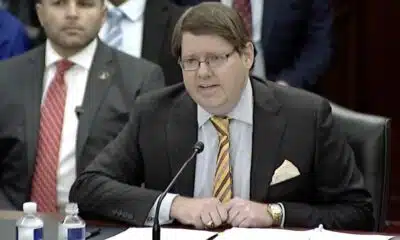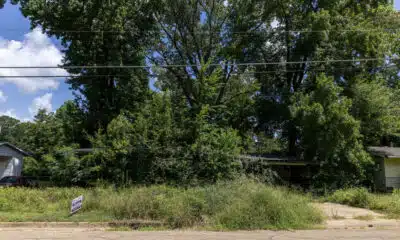News from the South - North Carolina News Feed
Why such extensive tree cutting in Biltmore Forest, especially along creeks? Patton Avenue work downtown still not finished? • Asheville Watchdog
Today’s round of questions, my smart-aleck replies, and the real answers:

Question: What’s up with all the extensive clearing by FEMA in Biltmore Forest? For the past couple months FEMA crews and heavy equipment have been taking down hundreds of mature live trees, excavating stumps, and clearing nearly all the understory in the lowland forest of Brooklawn Park (between Brookside Road, Brooklawn Chase and Hemlock Road). I asked FEMA employees twice for an explanation. Their vague answer said they were helping improve the waterway along the creek. Their clearing goes well beyond the stream, and I don’t know how removing live trees and extensive clearing can help a stream, wetland or surrounding floodplain. In fact, it has just the opposite effect. I also see extensive clearing of live trees in the nearby upland forest, which FEMA hauls away. It appears that Biltmore Forest has somehow persuaded FEMA to go beyond hurricane disaster relief for possible aesthetic reasons. If so, it is a misuse of FEMA funds. Does FEMA or Biltmore Forest have a valid explanation?
My answer: I don’t know, but they have suspiciously changed the town name to “Biltmore Bald.”
Real answer: Biltmore Forest Town Manager Jonathan Kanipe had a pretty darn long, and I’d say valid, explanation for all the tree cutting.
“The town was exceptionally fortunate not to have flooding or other damages like many places, but we had a catastrophic level of trees and vegetation that had to be cleared and removed,” Kanipe said via email.
The town, home to about 1,435 people, is handling the tree removal, by the way, not FEMA or the Army Corps of Engineers, although Kanipe said the town is abiding by federal requirements.
Kanipe said the town’s debris contractor has been on the job since Oct. 12.
“The right-of-way removal work is largely complete and, to date, just under 385,000 cubic yards of vegetative debris from the public right of way.,” Kanipe said, noting that Biltmore Forest is three square miles in size. “Buncombe County just announced their contractor has removed approximately 1.22 million cubic yards during their right-of-way removal program for unincorporated Buncombe County, the City of Asheville, and the Town of Black Mountain. This land area is approximately 645 square miles.”
Kanipe did the math for me.
“The amount of debris removed within Biltmore Forest is the equivalent of 31 percent of the Buncombe County, Asheville, and Black Mountain removals, while only accounting for roughly .47 percent of the land area,” Kanipe said. “Everyone in the storm-impacted region has done terrific work to assist in the region’s recovery and I am very proud of the work our team in Biltmore Forest has done.”
Kanipe said the work in Brooklawn Park includes both waterway and public park debris removal.
The town finished construction of its first trail there in May 2024, and it covered just over 1.25 miles in the park.
“The trail was heavily used prior to the storm but was inaccessible and completely covered in downed hardwoods and pine trees after the storm, as was the area within the stream,” Kanipe said. “The writer is correct that FEMA regulations are exceptionally specific in regard to what work can be done within waterway debris removal, and the town has met all these guidelines.”
Kanipe said the town works closely with its debris team — Southern Disaster Recovery for removal and DebrisTech for independent monitoring — “to ensure all work is being done within federal and state regulations, because if they are not done correctly, we do not get reimbursed.”
Before any work took place within Brooklawn Park, “a branch director for the FEMA debris task force met on site and reviewed the scope prior to any approvals being granted and work beginning,” Kanipe said.

“Additionally, the town’s removal contractor must receive approval from the independent monitor before any tree can be removed (even those that are leaning or hazardous) and these locations (as well as all debris generated) are recorded with GPS coordinates and more specific information relative to each load that is then hauled away,” he continued. “The portions of Brooklawn Park where debris or trees were removed not within the waterway, specifically, were areas in and along the trail system that courses through the entire 15 acres.”
The park restoration also included a secondary site visit by FEMA inspectors before any work occurred in the park.
“Many waterways in Biltmore Forest are located within our public park properties, so there is similar and approved work occurring all throughout the town,” Kanipe said. “The properties upstream of Brooklawn Park are privately owned and are large parcels that contained heavily mature forests that suffered tremendous losses during the storm.”
Kanipe said those property owners used their own contractors to bring storm debris to the public right of way for removal, “in accordance with all federal and state regulations, and the town’s contractor removed this material appropriately.”
“We have provided the landowner upstream with information regarding appropriate stream restoration for the portion on private property,” Kanipe added.
Biltmore Forest has been heavily engaged on stream restoration, and that started before Helene struck. Kanipe noted that the town received a grant last year from the North Carolina Land and Water Fund to create a town-wide stormwater and stream restoration plan, which is moving ahead.
“One small silver lining from Helene is that we are now able to access many of the stream areas that were completely enclosed with invasive species,” Kanipe said. “We are beginning a five- year invasive species removal plan this spring and our engineer is providing recommendations for stream stabilization in the short term and significant replanting in these corridors in the long term.”
Kanipe also addressed the reader’s assertion about tree removal being done for aesthetic reasons.
“This is simply not the case,” Kanipe said. “The town’s debris removal has been Herculean and, aside from it being contrary to federal and state regulations, we do not want to overburden our contractors with things that are not done for recovery and health and safety purposes.”
Biltmore Forest has provided updates about tree removal on its website. It includes daily debris collection reports “that show exactly how much was collected and what portion of the program it occurred in, such as waterways, parks, right of way, and all other information is continually available for review,” Kanipe said.
I also asked the FEMA public affairs team about the situation in Biltmore Forest, and if it had concerns.
“As of April 4, 2025, there have been no identified concerns with debris work in general for Biltmore Forest, or with anything specific to tree removal efforts either,” Fema public affairs stated. “Additionally, when debris is approved for removal, it’s because of the debris representing a specific threat to health, life, or safety or economic recovery aspects. Often it is possible that an element of debris may not immediately appear as a threat, but it creates a risk of future flood threat and thus removal is supported.”


Question: What’s the status of Patton Avenue in downtown Asheville? When will the work be done? Will the street be repaved? I drive down Patton Avenue two to three times a week and don’t see a lot of work going on. One of those days is Sunday so I give them a break.
My answer: I used to think this project would have no trouble finishing up before the I-26 Connector project, but I’m getting a little skeptical.
Real answer: Called the “Carter-Ann-Patton Stormwater Improvement Project,” this project includes new streetlights, stormwater improvements, improvements for sidewalks and utilities, and a new layer of asphalt. It’s also designed to help with localized flooding near the intersections of Carter Street, Patton Avenue, and South Ann Street.
Originally, it was supposed to wrap up in the winter 2024, according to the city’s webpage, but clearly it’s now going to reach the finish line this year.
“Paving and concrete work are coming to a close and, weather permitting, the project will wrap up, completing the final ‘punch list’ in May,” City of Asheville spokesperson Kim Miller said.
I last wrote about this in January, as the pavement through this area will rattle your bones and questions are frequent, and Miller said then the project delays “included a required redesign which accommodated previously unidentified utility conflicts in the area, as well as a month and a half delay from Helene impacts, as the contractor was diverted to support essential water system restoration efforts.”
You can track the project on the city’s webpage. It notes that this week they’ve closed three lanes on the south side of Patton between French Broad Avenue and Clingman Avenue. One westbound lane remains open on the north side.
Other traffic will be rerouted to Hilliard Avenue. Milling and paving of the eastbound lanes should be completed this week.
Beginning April 14, there will be a north side closure on Patton Avenue, with three lanes closed between French Broad Avenue and Clingman Avenue. One eastbound lane will remain open on the south side, with a detour continuing on Hilliard Avenue.
“Milling and paving of the westbound lanes will be completed by the end of the week,” the city states.
Another round of work should start April 21 and include night closures at French Broad and Clingman avenue intersections of Patton Avenue. Milling and paving on Carter Street will take place.
Asheville wheel realignment businesses, plan accordingly.
Asheville Watchdog is a nonprofit news team producing stories that matter to Asheville and Buncombe County. Got a question? Send it to John Boyle at jboyle@avlwatchdog.org or 828-337-0941. His Answer Man columns appear each Tuesday and Friday. The Watchdog’s reporting is made possible by donations from the community. To show your support for this vital public service go to avlwatchdog.org/support-our-publication/
Related
The post Why such extensive tree cutting in Biltmore Forest, especially along creeks? Patton Avenue work downtown still not finished? • Asheville Watchdog appeared first on avlwatchdog.org
News from the South - North Carolina News Feed
Ideas for helping NC child care industry are solidifying, but a top suggestion faces headwinds
SUMMARY: North Carolina’s Child Care Task Force, led by Gov. Josh Stein, Lt. Gov. Rachel Hunt, and Sen. Jim Burgin, is addressing child care affordability, workforce pay, and financial stability, especially in rural areas. Child care providers struggle financially due to low subsidies and high costs, with infant care averaging $11,720 annually statewide. Owners like Halee Hartley and Annette Anderson-Samuels work multiple jobs to sustain their centers. The task force prioritizes raising minimum subsidy reimbursement rates to support providers equitably across counties. Discussions include establishing a child care endowment fund, leveraging philanthropy to supplement funding amid uncertain state and federal budgets.
The post Ideas for helping NC child care industry are solidifying, but a top suggestion faces headwinds appeared first on ncnewsline.com
News from the South - North Carolina News Feed
Court docs show Harris Lake boating suspect had prior legal troubles
SUMMARY: Court documents reveal Quinton Kite, charged with causing a deadly boating accident at Harris Lake that killed a 10-year-old girl and critically injured a woman, had prior legal troubles. Kite was out on a $15,000 bond from a December 2023 felony hit-and-run charge involving Alex Meyers, who was seriously injured but survived. Dashcam and security footage showed Kite’s damaged truck after leaving the crash scene. Meyers expressed frustration that earlier legal action might have prevented the tragedy. Additionally, court records from New Mexico show Kite pleaded no contest to a 2009 DUI charge, completed probation, and attended DWI school.
That includes arrests in 2009 and pending charges from a hit-and-run in 2023 that injured a Vass resident.
https://abc11.com/post/quinten-kight-court-documents-reveal-prior-legal-troubles-man-charged-harris-lake-boating-tragedy/17435804/
Download: https://abc11.com/apps/
Like us on Facebook: https://www.facebook.com/ABC11/
Instagram: https://www.instagram.com/abc11_wtvd/
Threads: https://www.threads.net/@abc11_wtvd
TIKTOK: https://www.tiktok.com/@abc11_eyewitnessnews
X: https://x.com/ABC11_WTVD
News from the South - North Carolina News Feed
We saw a human skeleton in this video.
SUMMARY: The video showed a human skeleton, deeply affecting the family, especially their brother, Evatar, who is critically ill and near death. He’s described as a kind, musical soul who plays guitar, sharing music with the narrator, who plays the piano. The family is devastated, unable to watch the video, but focused on saving him. Doctors say Evatar has only days left and urgently needs food, medical care, and vitamins to survive. Despite his fragile state, his spirit remains unbroken, and both he and his family believe he will recover. The narrator longs for his warm hugs and smile.
ABC News’ Ian Pannell spoke to the brother of Evyatar David, an Israeli hostage seen in footage released by Hamas over the weekend.
Evyatar’s brother, Ilya, says the release of the video “crushed” his family and that doctors say his sibling has only a “few days to live.”
via @ABCNews
-
News from the South - Texas News Feed6 days ago
Rural Texas uses THC for health and economy
-
Mississippi Today2 days ago
After 30 years in prison, Mississippi woman dies from cancer she says was preventable
-
News from the South - Kentucky News Feed7 days ago
Harrison County Doctor Sentenced for Unlawful Distribution of Controlled Substances
-
News from the South - Texas News Feed7 days ago
Released messages show Kerrville officials’ flood response
-
News from the South - Alabama News Feed6 days ago
Decision to unfreeze migrant education money comes too late for some kids
-
News from the South - Louisiana News Feed7 days ago
‘Half-baked’ USDA relocation irritates members of both parties on Senate Ag panel
-
News from the South - Georgia News Feed3 days ago
Woman charged after boy in state’s custody dies in hot car
-
Mississippi Today6 days ago
They own the house. Why won’t they cut the grass?













































